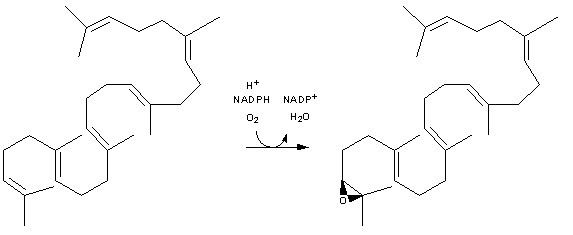EC number 1.14.13.132 ExPASy NiceZyme view | CAS number 9029-62-3 | |
 | ||
Squalene monooxygenase (also called squalene epoxidase) is an enzyme that uses NADPH and molecular oxygen to oxidize squalene to 2,3-oxidosqualene (squalene epoxide). Squalene epoxidase catalyzes the first oxygenation step in sterol biosynthesis and is thought to be one of the rate-limiting enzymes in this pathway. In humans, squalene epoxidase is encoded by the SQLE gene. Squalene monooxygenase (SqMO) was formerly referred to as squalene epoxidase (SqE) in the literature.
Contents
Mechanism
Squalene monooxygenase is a flavoprotein monooxygenase. Flavoprotein monooxygenase form flavin hydroperoxides at the enzyme active site, which then transfer the terminal oxygen atom of the hydroperoxide to the substrate. Squalene monooxygenase differs from other flavin monooxygenases in that the oxygen is inserted as an epoxide rather than as a hydroxyl group. Squalene monooxygenase contains a loosely bound FAD flavin and obtains electrons from NADPH-cytochrome P450 reductase, rather than binding the nicotinamide cofactor NADPH directly.
Inhibitors
Inhibitors of squalene epoxidase have found application mainly as antifungal drugs:
Since squalene epoxidase is on the biosynthetic pathway leading to cholesterol, inhibitors of this enzyme may also find application in treatment of hypercholesterolemia.
Localization
In yeast Saccharomyces cerevisiae, squalene epoxidase is localized to both the endoplasmic reticulum and lipid droplets. Only the ER localized protein is active.
Additional products
Squalene epoxidase also catalyzes the formation of diepoxysqualene (DOS). DOS is converted to 24(S),25-epoxylanosterol by lanosterol synthase.
Model organisms
Model organisms have been used in the study of SQLE function. A conditional knockout mouse line called Sqletm1a(EUCOMM)Wtsi was generated at the Wellcome Trust Sanger Institute. Male and female animals underwent a standardized phenotypic screen to determine the effects of deletion. Additional screens performed: - In-depth immunological phenotyping
